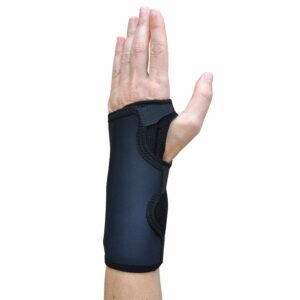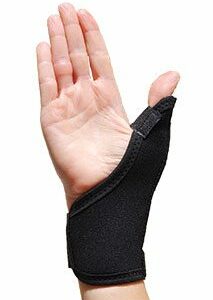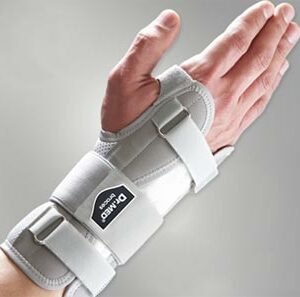Hand and Wrist Pain Diagnosis Guide
Updated:
Hand and wrist injuries are common following a fall onto an outstretched hand or in individuals involved in ball and contact sports or upper limb weight bearing sports (such as gymnastics). Patients suffering from hand and wrist pain are often seen in physiotherapy practice. Pain may be caused by local structures within or around the wrist or hand or occasionally, may be referred from other sources (such as the neck, upper back, shoulder or elbow).
One common clinical presentation is the patient suffering from sudden onset wrist pain typically as a result of a fall onto an outstretched hand, the cause of which is often torn ligaments or connective tissue around the wrist, such as a Sprained Wrist (figure 1) or occasionally a fracture such as a Radius Fracture (figure 1) or Scaphoid Fracture (figure 2). In patients who experience finger trauma in ball or contact sports, a Sprained Finger or Thumb is often the result (figure 3).
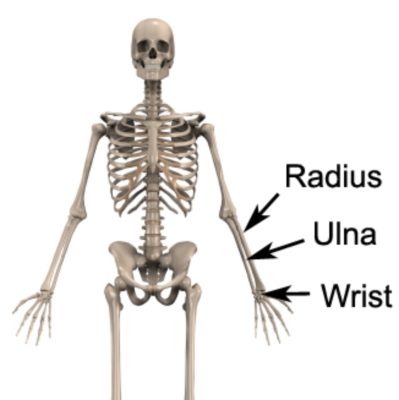
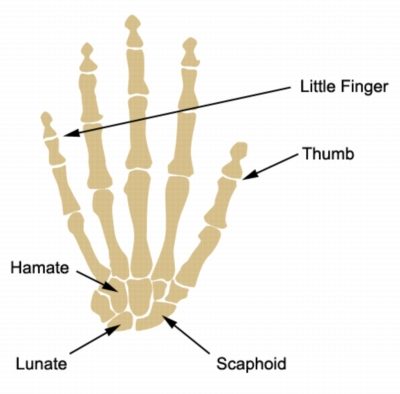
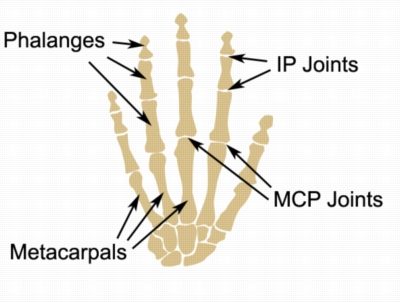
Gradual onset hand and wrist pain often develops as a result of overuse particularly in gripping activities such as racquet sports or manual work such as carpentry. One of the more common overuse wrist injuries is Wrist Tendonitis which involves gradual degeneration and inflammation of one or more wrist tendons. In those patients with associated neck, upper back, shoulder, elbow or forearm pain, Referred Pain (frequently from the neck, upper back, shoulder or elbow) is often the cause of symptoms. In older patients with gradual onset wrist pain associated with generalised wrist stiffness, Wrist Arthritis may be the source of symptoms. There are numerous other causes of hand and wrist pain, some of which present suddenly due to a specific incident, others which develop gradually over time.
Below are some of the more common causes of hand and wrist pain with a brief description of each condition to aid hand and wrist pain diagnosis. Conditions have been organised according to sudden or gradual onset and common or less common conditions for ease of use.
Find out what may be causing your hand or wrist pain:
Sudden Onset Hand and Wrist Pain – Common Injuries
Sprained Wrist
Tearing of connective tissue and / or ligaments of the wrist joint (figure 1) typically as a result of a fall onto an outstretched hand causing the wrist to stretch excessively. Associated with pain in the wrist that may increase when firmly touching the affected region of the wrist joint, restricted wrist joint mobility and often swelling.
Sprained Finger
Tearing of connective tissue and / or ligaments holding the bones of the finger together (figure 3) typically following excessive stretching of the joint in one direction. Associated with pain on firmly touching the affected joint, restricted joint mobility and often swelling.
Sprained Thumb
Tearing of connective tissue and / or ligaments holding the bones of the thumb together (figure 3) typically following excessive stretching of the joint in one direction. Associated with pain on firmly touching the affected joint, restricted joint mobility and often swelling.
Radius Fracture
A break in the radius bone near the wrist (figure 1) usually due to a fall onto an outstretched hand. Associated with severe pain usually located on the thumb side of the wrist that may radiate into the thumb, hand or forearm, in addition to swelling, tenderness on firmly touching the affected region of the bone, markedly reduced wrist function and sometimes bony deformity.
Scaphoid Fracture
A break in one of the wrist bones located on the thumb side of the wrist (scaphoid – figure 2, 4) usually due to a fall onto an outstretched hand. Associated with severe pain at the time of injury that may settle to an ache, usually located on the thumb side of the wrist. Swelling, tenderness on firmly touching the affected region of the bone and markedly reduced wrist function are also present.
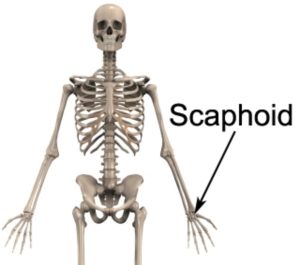
Metacarpal Fracture
A break in one of the metacarpal bones of the hand (figure 5) usually due to a punch, a direct blow to the back of the hand or a fall onto an outstretched hand. Associated with severe pain in the hand that may radiate into the wrist or fingers, in addition to swelling, tenderness on firmly touching the affected region of the bone, markedly reduced hand function and sometimes bony deformity.
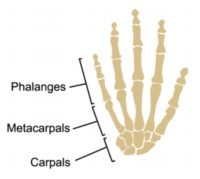
Phalanx Fracture
A break in one of the small bones of the finger (phalanges – figure 5) usually due to a traumatic direct blow to the finger such as during ball or contact sports. Associated with severe pain in the affected finger, swelling, tenderness on firmly touching the affected region of the bone, markedly reduced finger function and sometimes bony deformity.
Wrist impingement / impaction syndromes
Pain in the wrist due to compression or pinching of structures within the wrist joint usually during a traumatic end of range wrist movement (e.g. a fall onto an outstretched hand), typically with the wrist in extension and in combination with weight bearing forces through the affected wrist (such as during gymnastics). Symptoms may increase on firmly touching the affected region of the wrist and on certain wrist movements (e.g. wrist extension in weight bearing – figure 6).
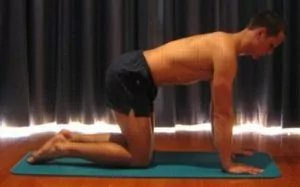
TFCC Tear
Damage to cartilage tissue located on the little finger side of the wrist joint (Triangular Fibro-Cartilaginous Complex TFCC – figure 7) usually due to excessive compression forces often in association with twisting or side bending forces through the wrist such as a fall onto an outstretched hand, or during gymnastics, racquet sports or manual work such as using a hammer. Pain is usually located on the little finger side of the wrist and can occasionally radiate into the forearm or hand. There is usually tenderness on firmly touching the affected tissue and often swelling. Reduced grip strength may also be present. In some cases a clicking or catching sensation may be experienced during certain wrist movements.
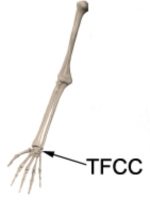
Dislocated Finger
Tearing of connective tissue surrounding one of the finger joints with subsequent displacement and separation of the bones forming the joint so the joint surfaces are no longer situated next to each other (i.e. the finger often appears deformed). Typically occurs as a result of a traumatic impact to the finger such as during ball sports and causes severe pain in the finger, a feeling of the finger ‘popping out’, deformity of the finger joint and sometimes pins and needles or numbness.
Referred Pain
Pain referred into the wrist or hand from another source such as the neck, upper back, shoulder or elbow frequently associated with symptoms above the wrist and hand (such as in the neck, upper back, shoulder, arm, elbow or forearm). Typically associated with pain on firmly touching the region responsible for the referred pain and / or loss of movement in that region. Sometimes in association with pins and needles or numbness in the affected arm or hand.
Less Common Sudden Onset Injuries
Hamate Fracture
A break in one of the small wrist bones located on the little finger side of the wrist (hamate – figure 2) usually following hitting the ground during a golf swing, swinging a tennis racquet, baseball bat or playing volleyball or due to a fall onto an outstretched hand. Associated with severe pain at the time of injury that may settle to an ache, usually located on the little finger side of the wrist / hand, on the palm side of the hand. Swelling and tenderness on firmly touching the affected bone are also typically present.
Lunate Fracture
A break in one of the small wrist bones located approximately in the middle of the wrist (lunate – figure 2) usually following a fall onto an outstretched hand. Associated with severe wrist pain at the time of injury that may settle to an ache and can occasionally radiate into the hand or forearm. Swelling and tenderness on firmly touching the affected bone are also typically present.
Distal Radio-Ulnar Joint Sprain
Tearing of connective tissue and / or ligaments of the joint located between the ends of the forearm bones just before the wrist (distal radioulnar joint – figure 8) typically as a result of a fall onto an outstretched hand, often in combination with twisting of the wrist and forearm. Associated with pain in the wrist that may increase when firmly touching the affected region of the joint, restricted wrist joint mobility (particularly rotation of the wrist) and often swelling.

Carpal Dislocation
Tearing of connective tissue joining adjacent small bones of the wrist (carpal bones – figure 5) with subsequent displacement and separation of the affected bones forming the joint so the joint surfaces are no longer situated next to each other. Typically occurs as a result of severe trauma such as a fall onto an outstretched hand and causes severe wrist pain, deformity of the wrist, pain on firmly touching the affected joint and sometimes pins and needles or numbness.
Kienbock’s disease
Gradual bony tissue death to one of the small bones located approximately in the middle of the wrist (lunate – figure 2) secondary to a loss of its blood supply. Typically occurs as a result of trauma to the wrist (such as a fall onto the outstretched hand). Usually associated with chronic pain located on the front or back of the wrist that increases on firmly touching the lunate bone (figure 2) and often reduced wrist range of movement. Pain may also increase during weight bearing activity through the wrist and general use of the hand. Most common in those aged in their twenties.
Finger Tendon Ruptures
Complete tearing of one or more finger tendons (figure 9), typically following a traumatic incident such as a direct impact to the finger during ball or contact sports. Associated with pain and swelling in the finger that may radiate into the hand, significant weakness of the affected finger and often deformity of the finger (e.g. a bent finger) that typically cannot be straightened by using the affected finger alone. Pain may also increase on firmly touching the affected tendon at the level of the finger.
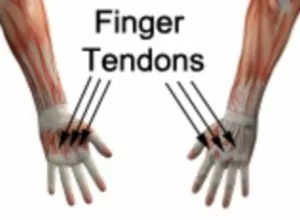
Ulnar Artery Aneurysm or Thrombosis
Damage to the ulnar artery located on the little finger side of the palm of the hand at the level of the hamate bone (figure 2) resulting in dilation of the artery and / or the formation of a blood clot. Typically occurs following trauma or repeated impact to this part of the hand (e.g. using this part of the hand as a hammer, or during a karate chop in martial arts). May result in pain, discolouration, numbness, coolness, pins and needles or numbness in one or more fingers and sometimes the little finger side of the palm of the hand. Occasionally, swelling or a mass on the little finger side of the palm of the hand at the level of the hamate bone may also be present.
Gradual Onset Hand and Wrist Pain – Common Injuries

Members Only ContentBecome a PhysioAdvisor Member to gain full access to this exclusive content. For more details see Become a Member. Already a member? Login Now
Less Common Gradual Onset Injuries

Members Only ContentBecome a PhysioAdvisor Member to gain full access to this exclusive content. For more details see Become a Member. Already a member? Login Now
Hand and wrist pain diagnosis
A thorough subjective and objective examination from a physiotherapist is usually sufficient to diagnose the cause of hand and wrist pain. Investigations such as an X-ray, ultrasound, MRI, CT scan or nerve conduction studies are often required to confirm hand and wrist pain diagnosis and rule out other injuries.
Find a Physio for hand and wrist pain diagnosis
Find a physiotherapist in your local area who can assist with hand and wrist pain diagnosis and can treat patients suffering from wrist injuries and hand injuries.
More Information
- View Wrist Stretches.
- View Hand Stretches.
- View Wrist Strengthening Exercises.
- View Hand Strengthening Exercises.
- View detailed information on initial injury management and the R.I.C.E Regime.
- View detailed information on when to use Ice or Heat.
- View detailed information on Wrist Taping.
- View detailed information on Finger Taping.
- View detailed information on Thumb Taping.
Physiotherapy products for hand and wrist pain
Some of the most commonly recommended products by physiotherapist for patients with hand and wrist pain include:
To purchase physiotherapy products to assist with rehabilitation click on one of the above links or visit the PhysioAdvisor Shop.
Become a PhysioAdvisor Member
-
 Individual Membership (12 Months)$59.95 for 1 year
Individual Membership (12 Months)$59.95 for 1 year -
 Individual Membership (3 Months)$39.95 for 3 months
Individual Membership (3 Months)$39.95 for 3 months -
 Individual Membership (Yearly)$49.95 / year
Individual Membership (Yearly)$49.95 / year -
 Individual Membership (Monthly)$15.95 / month
Individual Membership (Monthly)$15.95 / month

Link to this Page
If you would like to link to this article on your website, simply copy the code below and add it to your page:
<a href="https://physioadvisor.com.au/injuries/wrist-hand”>Hand and Wrist Pain Diagnosis Guide – PhysioAdvisor.com</a><br/>PhysioAdvisor provides a hand and wrist pain diagnosis guide for patients suffering from hand injuries and wrist injuries created by experienced physiotherapists.
Return to the top of Hand and Wrist Pain Diagnosis Guide.

